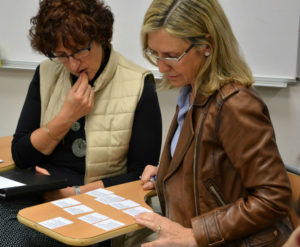Content and Language Integrated Learning (CLIL)
This course is also available online
2 weeks
Course Length
Mon to Fri
Lesson Days
15 a week
Lessons
English
Language
B1
Minimum Level
Overview
This course is aimed at foreign teachers who want to teach a specific subject using an innovative approach to CLIL methodology. We will enable our participants to understand more details on how to support second language learners by providing helpful hints to help students and increase their engagement.
Our training will deepen your understanding of mastery, rich tasks, and teaching to the top. Based on the expectation that all students are capable and expected to achieve high standards.
The aim of this course is to develop an understanding of the key challenges and benefits of CLIL, to consider methodology and teaching strategies, to share ideas and experiences within the classroom.
Completing this course will help you:
- To understand why CLIL is important.
- To familiarise themselves with ways they can integrate CLIL in an English Language course
- To appreciate the advantages of CLIL and design activities and tasks based on this approach.
- To recognise the disadvantages of CLIL and be critical of the contexts where it is used.
Who is the course for?
Course Sample programme
| Week 1 | Course Content |
| Monday | Introduction to the key principles of CLIL Learner styles and learner training |
| Tuesday | Compare teaching materials to understand the differences in implementing CLIL in different countries (bring your own teaching materials) |
| Wednesday | Developing oral communication skills Exploring techniques for correcting oral errors -Using task-based learning to develop speaking skills |
| Thursday | Developing students’ reading and writing skills Exploring ways of exploiting written texts for cross-curricular language |
| Friday | Developing subject-specific materials Evaluating, selecting and adapting published and authentic materials for a CLIL curriculum |
| Week 2 | |
| Monday | Using technology to enhance learning: computers and the language laboratory |
| Tuesday | Syllabus and course design |
| Wednesday | Integrating pronunciation: activities to help with sounds, stress and intonation |
| Thursday | Using project work in the classroom |
| Friday | Exploring different approaches to testing and assessment – Course review |
*Please note that the course content may be subject to change due to latest methodology trends updates.
1 lesson=45mins
Share This Class:
What people are saying



More Courses
You might also be interested in these courses

Technology for Language Teachers
Technology for Language teachers is aimed at teachers who want to use more technology in the classroom to enhance the learning experience of their students…

Teaching for Exam Classes
Teaching for Exam Classes is for English teachers who are preparing teenage or adult students for exams. Preparing to teach Cambridge or IELTS exam class. London…

Pronunciation and Performance with an expert “Adrian Underhill”
Pronunciation and Performance with an expert is a course led by a world-renowned ELT Consultant and Trainer. Adrian Underhill is an author and the series…

Practical Teacher
Practical Teacher is suitable for teachers who want a practical programme that covers developing resources, practical ideas and methods to liven up classrooms…

Life in Britain
Life in Britain is for teachers interested in finding out about modern British culture. The topics will be taught using a communicative methodology…

Language Development and Teaching Skills
Language Development and Teaching Skills Course is suitable for teachers who want to develop their own knowledge and use of English for the classroom…
Methodologies

Total Physical Response
Total Physical Response is considered to be an excellent way of learning vocabulary. Moreover, since it is based on commands, the students can easily learn the meaning of the words in the target language.

The Structural Approach
This method is based on the opinion that it is imperative to understand the structures of the language. Understanding the complexities of the structures of the sentences in a language is more important than learning the vocabulary of the language.

The Direct Method
This method primarily focuses on the development of oral skills. One of the most important characteristic feature of this method is that visual materials and real-life objects are used. Moreover, such an oral training helps in reading and writing. There is no translation involved in this method.
